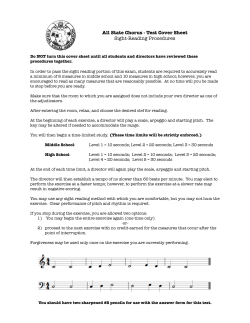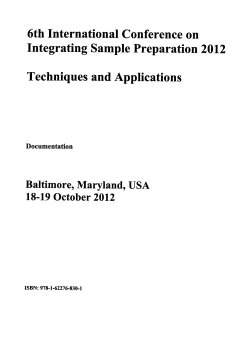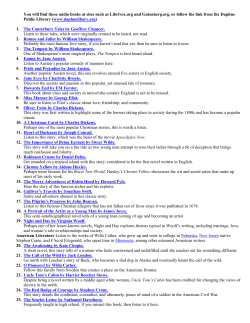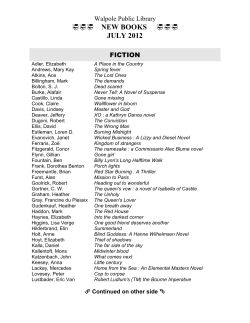
book here
StudySync Lesson Plan A Tale of Two Cities Objectives 1. Engage students in the plot, characters, themes, setting, and language of Charles Dickens’s A Tale of Two Cities so that they are prepared to discuss and write about the excerpt and/or the entire novel. 2. Practice and reinforce the following Grade 11-12 ELA Common Core Standards for reading, writing, and speaking and listening: READING: LITERATURE – RL.11-12.1-6, 9, 10 WRITING – W. 11-12.1-9 SPEAKING AND LISTENING – SL.11-12.1-6 Time 115 minutes (with up to an additional 110 minutes of extension possibilities) Materials SyncTV Premium Lesson on Charles Dickens’s A Tale of Two Cities Overview This excerpt, taken from chapter one of A Tale of Two Cities, takes the pulse of the novel’s complex dual setting. It immediately launches into a parallel comparison of London and Paris in the year 1775, including the reigns of the respective monarchs, the British and French economies, and such social issues as crime, political unrest, religion, and popular belief in the supernatural. Close examination of this excerpt will prepare students to read the entire novel, and to write thoughtful, informed, and textually-rooted responses, consistent with the ELA Common Core Standards for the high school grades. studysync.com Page 1 Lesson Plan: A Tale of Two Cities Background (10 minutes) 1. Watch the Preview (SL.11-12.1-3). As a group, watch the video preview of the premium lesson. Use the following questions to spur discussion following the preview: a. What do you already know about the 1770s, the time period in which this novel takes place? What do you know about the cities of London and Paris? b. Why were the following images used in the preview: Big Ben, the Eiffel Tower, manor house, mouse, soldier with musket, graveyard, teacup and saucer, bridge in fog, Dickens? c. Based on these images and the narration, what do you infer the excerpt will be about? Extension (additional 5 minutes) d. Describe (ELL). Locate London and Paris on a map. Ask English Language Learners to write one or two words about each of these two cities. Ask students to write one or two words to describe each individual image in the preview or describe a feeling it produces. e. Create (W.11–12.2–4). Based on the preview, have students write the text of a postcard someone might have sent from London or Paris in the 1770s… had there been postcards. What attractions or problems might the sender have written about? Engaging the Text (105 minutes) 2. Read the Text (20 minutes) a. Read and Annotate (RL.11-12.1-6, 10). Have students read and annotate the excerpt from A Tale of Two Cities. After students read, have them write what they understand from the text. If students are completing as a homework assignment, ask them to write any questions they have into the annotation tool–these questions are visible to you after the students submit their writing assignments or beforehand if you use the “mimic” function to access the students’ accounts. Extension (additional 45 minutes) b. Listen and Discuss (SL.11-12.1-2). As a class, listen to the seven-minute audio reading of the text. Ask the students to write how their understanding changed. Optionally, listen a second time and have students share how their understanding of the text changed after repeated exposures. What additional images came to mind? c. Comprehend (RL.11-12.1-6). Have students complete the multiple-choice questions individually. Collect papers or discuss answers as a class. 3. Watch SyncTV (25 minutes) a. Watch. Either watch the SyncTV discussion associated with A Tale of Two Cities as a class or ask students to watch it on their individual computers. studysync.com Page 2 Lesson Plan: A Tale of Two Cities b. Focus (SL.11–12.1-3 and RL.11-12.1-6). Use the portion of the SyncTV discussion from 1:32–2:30 to introduce the rhythm of opposites Dickens establishes and to summarize the “big picture” issues in the excerpt. c. Focus (SL.11–12.1-3 and RL.11-12.4-6). Re-watch the portion of the SyncTV discussion from 5:00–6:25 to compare how in 1775 as today, the so-called “best of times” may precede an economic recession. d. Focus (SL.11–12.1-3 and RL.11-12.4-6). Re-watch the portion of the SyncTV discussion from 7:04–7:47 and 8:27–9:30 to focus on how the opposites can occur at the same time, creating the conditions for revolution. e. Discuss (SL.11-12.1-5). After watching the model discussion, have a conversation with the class about the ideas discussed in the SyncTV episode that stood out the most. What new thoughts do they have after hearing the students' discussion? Next, divide students into small groups (3-4 students). Move around the room monitoring the groups as students follow the SyncTV episode as a model to discuss some of the following questions: i. Who is mainly responsible for the events described in this overview of 1775? Is it the monarchs of England and France? Is it the inevitable cycle of time? Is it some combination of people and fate? Explain your opinion. ii. Are all revolutions the same? Compare the conditions leading to the American Revolution with the conditions described in the excerpt that led to the French Revolution. How were the causes and outcome similar and different? iii. This excerpt is independent of the main events of the novel. Why do you think the author chose to begin the book in this way? What does this introduction imply about the nature of the events that will follow? iv. What point is Dickens making by discussing the popularity of supernatural revelations and the prevalence of crime in 1775? v. The SyncTV students discussed the idea that events in history follow the rhythm of a pendulum swinging from one extreme to the other, either at different times or even at the same time. Do you agree? Can you think of other examples in current history? vi. How do you feel about the text of the excerpt? Was the text “crazy difficult” for you as a reader? If so, what parts were difficult for you? If not, how would you clarify those sections that others found difficult? Extension (additional 60 minutes) f. Research (W.11-12.1-2.4-8). Have students work individually or in pairs to complete either of the following assignments: 1. Identify one current or recent example of a country that has experienced a boom of prosperity followed by economic recession. Is this pattern inevitable or can it be remedied? Write a paragraph detailing your findings. 2. Identify one current or recent example of a country that has experienced a great disparity of power and privilege between groups, and revolution brewing, or underway. What events have studysync.com Page 3 Lesson Plan: A Tale of Two Cities led to revolution? 4. Think (10 minutes) a. Respond (W.11-12.1, 4). Ask students to read the “Think” questions, watch the corresponding video clips, and respond to the questions, either in class or for homework. 5. Write (50 minutes) a. Discuss (SL.11-12.1–3). Read the prompt you have chosen for students, and then solicit questions regarding the prompt or the assignment expectations. Whichever prompt you have chosen, make sure students are clear about the assignment’s expectations and the rubric by which they will be evaluated. b. Organize (RL.11-12.1-6, 10 and W.11-12.1-2, 5). Ask students to go back and annotate the text with the prompt in mind. They should be organizing their thoughts and the points they’ll address in their writing as they make annotations. If you’ve worked on outlining or other organizational tools for writing, this is a good place to apply them. c. Write (W.11-12.1-2, 4-6, 9-10). Have students follow the writing process by planning, revising, editing, and publishing their written responses. d. Review (W.11-12.4-6). Use the StudySync “Review” feature to have students complete one to two evaluations of their peers’ work based on your chosen review rubric. Have the students look at and reflect upon the peer evaluations of their own writing. What might you do differently in a revision? How might you strengthen the writing and the ideas? studysync.com Page 4 Lesson Plan: A Tale of Two Cities SUPPLEMENTARY MATERIALS Key Vocabulary 1. retinue (n.) – group of advisers, assistants, or others accompanying an important person. 2. atrocious (adj.) – horrifyingly wicked. 3. pilferer (n.) – one who steals small quantities of things 4. requisition (n.) – a formal written request for something needed 5. blunderbuss (n.) – a short musket with a wide bore and flaring muzzle used to scatter shot at close range 6. incredulity (n.) – state or quality of disbelief 7. concede (v.) – to admit or acknowledge reluctantly 8. epoch (n.) – a specific period of history, especially one considered remarkable or noteworthy. Reading Comprehension Questions 1. In what year does the story occur? a. 1815 b. 1796 c. 1775 d. 1912 2. Why was a French youth sentenced to be tortured and killed? a. He had been caught stealing bread for his mother who was starving. b. He had failed to kneel to a procession of monks passing by. c. He had broken the Sabbath day observance by failing to attend church. d. He was a spy working on behalf of Britain’s American colonies. 3. What is referred to as “a certain immoveable framework with a sack and a knife in it…”? a. tumbril b. outhouse c. plow d. guillotine 4. In the opening lines of the excerpt, Dickens uses a. parallelism b. contrast c. both a and b d. alliteration 5. Which of the following best describes this excerpt? a. sentimental and positive b. factual and impersonal c. gloomy and outraged d. critical and ironic studysync.com Page 5 Lesson Plan: A Tale of Two Cities 6. What does the author reference in this sentence: “Mere messages in the earthly order of events had lately come to the English Crown and People from a congress of British subjects...”? a. Americans were asking independence. b. British citizens were supporting the King. c. Americans were paying their taxes. d. Supernatural messages were reported. 7. Dickens believes the French economy a. relied on worthless paper money b. was more stable than the British c. was based on wood and farming d. suffered from loans to America 8. Describing France’s “humane achievements” is an example of a. exaggeration b. personification c. understatement d. irony 9. In the year 1775 which criminal is active in London? a. Jack the Ripper b. Turnham Green c. Highwayman d. Mrs. Southcott 10. Crime in France compared to England is a. more violent. b. more political. c. more financial. d. more supermatural. Answer Key 1. C 2. B 3. D 4. C 5. D 6. A 7. A 8. D 9. C 10. B studysync.com Page 6 Lesson Plan: A Tale of Two Cities Further Assignments 1. Have students read A Tale of Two Cities in its entirety. Then pose the question: Did Sydney Carton die a hero’s death? Students should support their opinions in a welldeveloped argumentative essay, including evidence from the text to support their claim and optionally, arguments refuting the counterclaim. (RL.11-12.1–6 and W.11–12.1, 4, 9) 2. After they have read A Tale of Two Cities, have students select two characters in the novel to analyze and compare. Have them create a table listing each character’s traits in bullet points. Then ask them to write or present a comparison of each character’s impact on the events of the novel and on other characters, including each other. Remind students to support their claims with evidence from the text. (RL.11-12.1–6; W.11-12.2, 4, 9; SL.11–12.4) 3. Based on the model of the excerpt, have student partners or individuals research and write a “best of times/worst of times” exploration of another setting in history. It can contrast two different places, such as the North and South during the Civil War; or present the contradictions within one place, such as embattled Syria or red state/blue state America. (W.11-12.2, 4, 7–8) 4. Have students research and create a PowerPoint presentations about the French Revolution. Presentations should provide key historical facts and data, along with visual and audio components that provide classmates with context about the time period. Each student should be prepared to make a three to five-minute presentation to the class. (SL.11-12.4) 5. Ask students to write a letter or diary entry from Lucie Manette after Sydney Carton’s death in France. The letter should detail how Lucie’s father’s life was saved and express her thoughts and feelings about the events. (W.11-12.2-4, 9) 6. Have students use the model of the first paragraph of the excerpt to generate a list of opposites or contrasts, and create sentences for each word or pairs of words. Complexity can vary according to fluency. For example: We worked at night. We played in the day; the instructors were furious. The learners were calm. Encourage students to use a thesaurus to find antonyms. (ELL) studysync.com Page 7 Lesson Plan: A Tale of Two Cities
© Copyright 2025

















